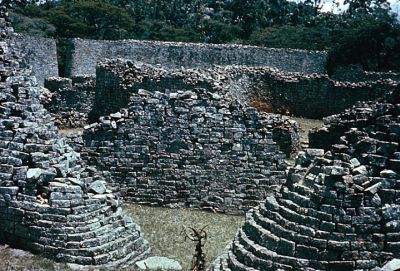The Changamire dynasty of rulers emerged from the Shona people who had founded the state of Monomutapa around 1500. Named after its founder Changa (also known as Changamir), Changamire had been a province of Monomutapa but with the rise of civil wars and the Portuguese occupation of Monomutapa’s capital, the Changamir seized the opportunity to establish a new state called Rozwi which later became known as Changamire. Changamir broke free of Monomutapa and led a mass migration to the area in modern Zimbabwe near Bulawayo. Changamir and his successors conquered the indigenous people and ruled the region between the Zambezi and Limpopo Rivers (now modern Zimbabwe) until 1830.
From two prosperous capitals, Khami and later at Dhlo Dhlo, Changamire rulers established a new empire. The indigenous farmers there provided food for Changamire and labor for the massive stone structures that dotted the Changamire state. Many of these buildings were royal property and their stone architecture included countless worked gold ornaments and reflected the power and authority of the elite rulers. The terracing of the older Khami site and two enormous man-made platforms at Dhlo Dhlo reflect the connection of the Changamire rulers to the tradition of monumental stone structures in an earlier Shona culture: Great Zimbabwe (8th century to 16th century).
The ruins of Khami, in particular, reveal the rich architectural history of the Changamire dynasty and the Shona tradition. Revetments and retaining walls with elaborate decorations transform the landscape of kopjes into terraces. Stone structures form open-air passageways lined with ornamental friezes of checkerboard and chevron patterns. Khami housed Changamire’s elites as made evident through the luxury goods of gold and glass beads, bronze and iron weapons, and ivory objects. Additionally, soapstone birds, a hallmark of the Great Zimbabwe culture, have been found in the remains and in the ruins of other Changamire cities.
Changamire’s success stemmed from its control of gold mining and processing in the region and to a lesser extent, its ability to incorporate farmers and laborers into its armies. As such the state was the most powerful in Southern Africa. Their success put them in conflict with growing Portuguese power along the coast. When the Portuguese refused to pay tribute to Changamire, they were attacked. Thus began a nearly century long struggle between these African and European powers. The Portuguese were able to resist conquest. However by the 1820s, Changamire faced a new threat unleashed by the rise of the Zulu Empire. As that empire expanded, new military powers rose in Southern Africa including the Ndebele and Ngoni. Those states eventually conquered Changamire by 1830, ending a series of powerful centralized states traced back more than 1,000 years to Great Zimbabwe.

